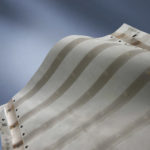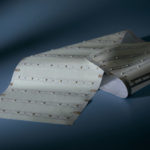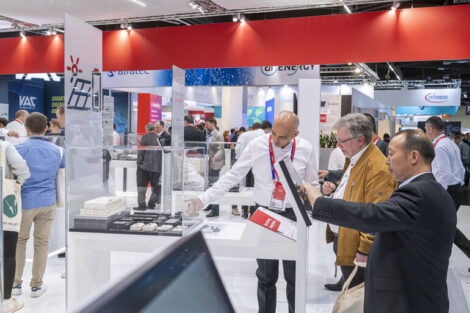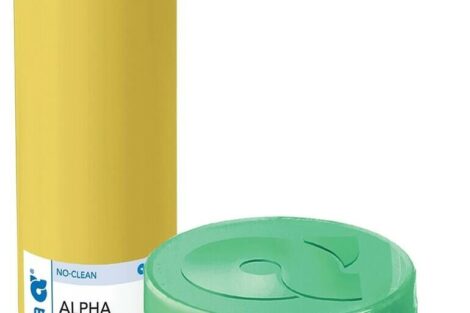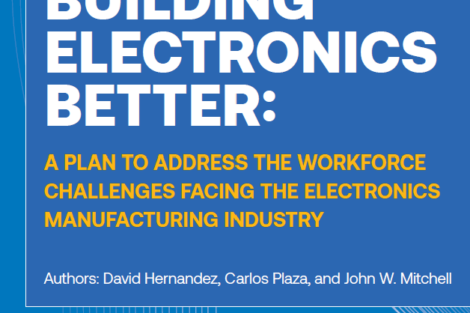In cooperation with its technology partners, the Swabian LED company Lumitronix, succeeded in equipping plasma-metallized flexible printed circuit boards with electronic components. This is based on the one-of-a-kind process of plasma metallization. The novel technology from the field of medical engineering turns a plurality of materials into electrically conducting and solderable printed circuit boards that were not suitable for an assembly with electronic components up to this point in time.
Plasma metallization: 10 years of research and development
“Within the framework of this special type of metallization, a patented plasma spray head is used to spray a conductive metal – mostly copper – in the form of a powder under high atmospheric pressure onto the basic material coated with silver paste. Simultaneously, the copper is fused by a very hot plasma beam of 10,000–50,000 °C, whereby a connection with the silver substrate is being formed. This metallization process provides for a conductive basic material and ensures that it can be soldered and ultimately equipped with electronic components in the further course of production”, says Christian Hoffmann, CEO.
This process has its origins in the field of medicine; however, this know-how was transferred to the field of electronics and, with plasma metallization, a process was created that will be used as the standard from now on.
Affordable basic materials as PCBs
When compared to the standard material polyimide, forming the basis for the majority of all flexible printed circuit boards available on the market, the process of plasma metallization results in a plurality of new and affordable basic materials for printed circuit boards.
So far, solderable paper FPCs (FPC = Flexible Printed Circuit) are a novelty and, because of the new technology, offer a plurality of applications. They are affordable, have no diffusion barrier and are thus suitable for large-scale applications.
PET may also serve as a basic material for FPCs. This plastic material is cheaper than polyimide, is characterized by a very good strength, a high resilience, and a low weight. When coated with a thin aluminum layer, which is rendered solderable via plasma metallization, the PET FPCs may be equipped with components. Furthermore, it is transparent and can therefore be applied to glass surfaces, for instance.
Aluminum FPCs coated with copper may be used in order to achieve both cost savings and a weight reduction when compared to pure copper FPCs. Thanks to 100 µm thick aluminum, the FPCs are also provided with a high current load capacity and may be used for interior and exterior applications. Since the surface of aluminum is not solderable without further ado, it has not been used in the field of flexible printed circuit boards up to now.
Advantages of plasma metallization
When compared to the standard process utilized for printed FPCs, wherein the basic material printed with non-solderable strip conductors – e.g. made of aluminum – is coated by means of a conductive adhesive with a high silver content, the plasma metallization method is much cheaper. The high silver content used within the framework of the conventional process results in significantly higher financial expenditures and additionally is complex. Furthermore, it is not that reliable, since the conductivity ultimately depends on temperature and moisture.
Another advantage of plasma metallization is that the high current – more than 10 A, preferably 50 A – and the low voltage – preferably 50 V – used within the framework of the process of irradiation prevent the complete breaking of the molecule chains of the coating material. However, the exclusion of oxygen results in the prevention of a direct oxidation of the coating material within the plasma beam. Therefore, high energies for starting the chemical reaction may be introduced into the coating material, which is why this method is suitable for continuous, industrial coating processes with high coating rates.
Series production
Series production of the flexible printed circuit boards will be performed on a Lumitronix in-house production line. The flexible strip park will be capable of equipping the basic printed circuit boards using the reel-to-reel process. Due to high processing speeds, production may be implemented on a large industrial scale. The particularity of the flex line is that all possible flexible materials may be processed there. Starting with the standard flex material polyimide, via wallpapers or paper up to very affordable plastic (PET).
The company’s production line allows for serially equipping basic material that is present in the form of reels. These reels are chucked at the beginning of the lines and tightened along the entire length by clamp supports – also referred to as hitch feeders – so that the further processes of coating with solder paste and equipping with LEDs and other components may be performed smoothly. Upon the step of equipping, the flexible printed circuit boards are soldered in an infrared oven and then checked electronically and optically by a machine. Afterwards, the flexible printed circuit boards may be cut to individual lengths and different patterns, respectively, by oscillating blades. Additionally, a special printer allows for printing the flexible printed circuit boards in.
Advantages of flexible printed circuit boards
When compared to rigid printed circuit boards, FPCs are characterized by several advantages. Due to their flexible basic material, they can be used individually and due to their low weight, they additionally provide luminaire manufacturers with more creative leeway. Furthermore, it is possible to implement whole new dimensions when it comes to the length. When compared to rigid printed circuit boards made of FR4 or aluminum, flex PCBs are cheaper and may be subjected to a higher dynamic und mechanical load without being damaged.
Thanks to processing the FPCs in the form of reels with a length of 50 to 100 m, the storage and transportation expenditures are lower as well. Additionally, large-scale manufacturers benefit from this form of printed circuit boards, since they are able to further process these on their own production line immediately and in an automated manner.
Applications of the novel technology
“As a matter of principle, this novel technology may be used to render any thinkable basic materials conductive and solderable,” says Hoffmann. Large-area special applications may also be implemented. For instance, metallized paper or PET film equipped with LEDs may be used. A conductive surface may even be applied to functional textiles, then be equipped individually with LEDs and additional electronic components.
Another option is rapid prototyping, within the framework of which strip conductors made of silver paint are printed to paper using an ink-jet printer, then plasma-metallized, and then equipped. The printing process is significantly easier and less complex when compared to the conventional etching process, with the latter being very complex and cost-intensive specifically for small numbers.


